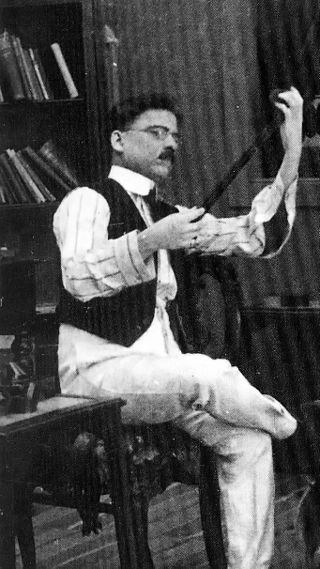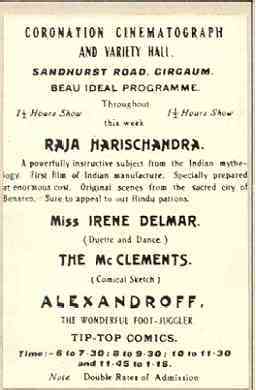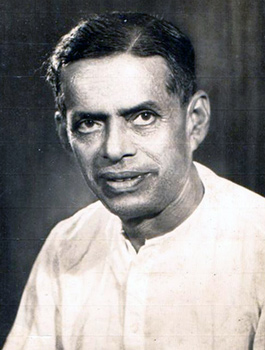Related Research Articles

The Dadasaheb Phalke Award is India's highest award in the field of cinema. It is presented annually at the National Film Awards ceremony by the Directorate of Film Festivals, an organisation set up by the Ministry of Information and Broadcasting. The recipient is honoured for their "outstanding contribution to the growth and development of Indian cinema" and is selected by a committee consisting of eminent personalities from the Indian film industry. The award comprises a Swarna Kamal medallion, a shawl, and a cash prize of ₹1,000,000 (US$13,000).

Prithviraj Kapoor was an Indian actor who is also considered to be one of the founding figures of Hindi cinema. He was associated with IPTA as one of its founding members and established the Prithvi Theatres in 1944 as a travelling theatre company based in Bombay.

Dhundiraj Govind Phalke, popularly known as Dadasaheb Phalke, was an Indian producer-director-screenwriter, known as "the Father of Indian cinema". His debut film, Raja Harishchandra, was the first Indian movie released in 1913, and is now known as India's first full-length feature film. He made 95 feature-length films and 27 short films in his career, spanning 19 years, until 1937, including his most noted works: Mohini Bhasmasur (1913), Satyavan Savitri (1914), Lanka Dahan (1917), Shri Krishna Janma (1918) and Kaliya Mardan (1919).

Raja Harishchandra is a 1913 Indian silent film directed and produced by Dadasaheb Phalke. It is often considered the first full-length Indian feature film. Raja Harishchandra features Dattatraya Damodar Dabke, Anna Salunke, Bhalchandra Phalke, and Gajanan Vasudev Sane and is based on the legend of Harishchandra, with Dabke portraying the title character. The film, being silent, had English, Marathi, and Hindi-language intertitles.

Ramchandra Gopal Torne, also known as Dadasaheb Torne was an Indian director and producer, best known for making the first feature film in India, Shree Pundalik. This historic record is well established by an advertisement in The Times of India published on 25 May 1912. Several leading reference books on cinema including The Guinness Book of Movie Facts & Feats, A Pictorial History of Indian Cinema and Marathi Cinema : In Restrospect amply substantiate this milestone achievement of the pioneer Indian feature-filmmaker.

Marathi cinema is an Indian film industry of Marathi-language motion pictures. It is based in Mumbai,Pune Maharashtra. Film Production in Mumbai, Pune. It is the oldest film industry of Indian cinema. The first Marathi film to be released in India was Shree Pundalik by Dadasaheb Torne on 18 May 1912 at Coronation Cinematograph, Mumbai. and a Marathi crew who were performing Marathi and Sanskrit Sangeet natikas (musicals) and plays in Marathi at that period.
D. D. Dabke or Dattatraya Damodar Dabke was an actor in the first ever Indian full length silent film Raja Harishchandra, directed by Dadasaheb Phalke in 1913. He co-starred with Anna Salunke. He acted in three more movies Satyavadi Raja Harishchandra (1917), Lanka Dahan (1917), Shri Krishna Janma (1918) and later became a cinematographer, as well as a director. He directed the 1924 remake of Raja Harishchandra

Harishchandrachi Factory is a 2009 Indian Marathi-language biographical film written and directed by Paresh Mokashi. It is about Dadasaheb Phalke, who made the first Indian feature film Raja Harishchandra (1913), and starring Nandu Madhav as him and Vibhavari Deshpande as his wife Saraswati. Harishchandrachi Factory focuses on the struggle Phalke faced during its production.
The Indian Animation Industry encompasses traditional 2D animation, 3D animation and visual effects for feature films. In 1956, Disney Studios animator Clair Weeks, who had worked on Bambi, was invited to Films Division of India in Mumbai to establish and train the country's first animation studio as part of the American technical co-operation mission. He trained a core group of Indian animators, whose first production was a film called The Banyan Deer (1957). Veteran animator Ram Mohan started his career at Films Division's Cartoon Unit.
Harishchandra is an Indian king mentioned in ancient Hindu religious texts.
The 1st National Film Awards, presented by Ministry of Information and Broadcasting, India to felicitate the best of Indian Cinema censored in the year 1953. Ceremony took place at Vigyan Bhavan, New Delhi on 10 October 1954 and awards were given by then President of India, Dr Rajendra Prasad.

Paresh Mokashi is an Indian filmmaker, producer, actor and Theatre director-producer; working predominantly in Marathi cinema and Marathi theatre. He started working as a backstage worker for theatre and did few minor roles for plays as well as films. Mokashi made his directorial debut for theatre with the Marathi play, Sangeet Debuchya Mulee in 1999. He continued to work for theatre and made his directorial debut for cinema with the 2009 Marathi feature film, Harishchandrachi Factory. The film depicts the making of India's first full-length feature film, Raja Harishchandra (1913), made by Dadasaheb Phalke. The film was acclaimed critically and won several awards. It was also selected as India's official entry to 82nd Academy Awards in the Best Foreign Language Film category.

Shree Pundalik, which was released on 18 May 1912 at the Coronation Cinematograph, Girgaum, Mumbai, is sometimes considered the first feature-length Indian film by a minority. The government of India and most scholarly sources consider Raja Harishchandra to be the first Indian feature film, and detractors argue Pundalik was only a photographic recording of a popular play. It was produced and directed by Dadasaheb Torne.
Durgabai Kamat was a Marathi actress, who was the first actress in Indian cinema.
Satyavadi Raja Harishchandra is a 1917 silent black and white Indian short film directed and produced by Dhundiraj Govind Phalke. The film is a shorter version of the first Indian feature film, Raja Harishchandra (1913), also directed and produced by Phalke. The intertitles used in the film were in Marathi language as the film was a silent film. The film is based on the mythological story of a Hindu King Harishchandra, the 36th king of the Solar Dynasty, who donated his entire kingdom and sold himself and his family to keep the promise given to the sage Vishvamitra in the dream.

Lanka Dahan is a 1917 Indian silent film directed by Dadasaheb Phalke. Phalke also wrote the film based on an episode of the Hindu epic Ramayana, credited to Valmiki. The film was Phalke's second feature film after the 1913 Raja Harishchandra, which was the first Indian full-length feature film. Phalke also directed various short films in between.
Mohini Bhasmasur is a 1913 Indian mythological film directed by Dhundiraj Govind Phalke and starring Kamlabai Gokhale and Durgabai Kamat. It is India's and Phalke's second full-length feature film. Mohini Bhasmasur is the first Indian film to have a female actor. In Raja Harischandra, India's and Phalke's first film, the role of the female was played by Anna Salunke, a male.

Anna Hari Salunke, also known as A. Salunke and Annasaheb Saluke, was an Indian actor who performed female roles in very early Indian cinema and also a cinematographer. He is credited as the first person to perform as a heroine in Indian cinema when he played the role of Rani Taramati of King Harishchandra in Dada Saheb Phalke's first full-length film, Raja Harishchandra (1913). In 1917, Salunke became the first to play a double role in Indian cinema, by playing the roles of both the hero and heroine in Lanka Dahan.
The history of animation in India can be traced to the early 20th century. Precursors to modern animation such as shadow puppets and slide shows entertained audiences before the advent of the cinema. Pioneers such as Dadasaheb Phalke, Gunamoy Banerjee, K.S. Gupte and G.K. Ghokle kept the tradition of animation alive during the first half of the 20th century. Such individuals were usually self-taught and were inspired by foreign cartoons.
References
- ↑ Bhowmik, kaushik. "The emergence of the Bombay film industry, 1913 - 1936". A Thesis. Retrieved 21 May 2014.
- ↑ Kaur, Raminder; Sinha, Ajay (2005). Bollyworld: Popular Indian Cinema Through A Transnational Lens. New Delhi, India: Sage Publications. ISBN 978-0761933205.
- ↑ "Happy birthday Bollywood: Indian cinema enters 100th year". IBN Live. 3 May 2012. Archived from the original on 1 January 2014. Retrieved 21 May 2014.
- ↑ "Coronation cinematograph, page 641". The Times of India Directory. 1912.
- ↑ Baghdadi, Rafique. "From playhouse to movie theatre". Experts speak. National Film Archive of India. Retrieved 21 May 2014.
- ↑ Bose, Ishani (25 April 2013). "Dadasaheb Torne, not Dadasaheb Phalke, was pioneer of Indian Cinema". Daily News Analysis Pune. Retrieved 21 May 2014.
- ↑ Edwardes, S.M. (1909). The Gazetteer of Bombay City and Island. Bombay. p. 364.
- ↑ "Cinema on 18 May 1912". Indian Age. Retrieved 21 May 2014.
- ↑ Gajendragadkar, Nikhil. "Beginning of the dream world..." Deccan Herald. Retrieved 21 May 2014.
- ↑ "Publicity poster - Raja Harischandra". 1913. Retrieved 21 May 2014– via Wikimedia commons.
- ↑ Dwyer, Rachel (2006). Filming the Gods: Religion and Indian Cinema. Routledge. p. Chapter 2. ISBN 978-0415314251.
- ↑ Encyclopedia of Indian Cinema. Oxford University Press. p. 227.
- ↑ Mohamed, Khalid (17 May 2013). "Happy 100th Birthday". Khaleej Times. Retrieved 21 May 2014.